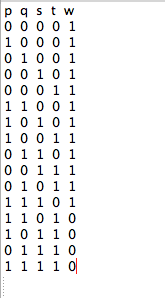Hi can anyone help me figure out the truth table for this circuit? The output is w and the inputs are p, q, s, t. I have provided my answer for the truth table below, but I itit probably wrong.


Can someone explain to me how this works? I know in nmos 0 opens switch and 1 closes, and a pmos is the reverse of this. My problem is, I am not sure what happens if:
1) s & q are open (at the bottom)? Am i right in thinking if only one is open, w will be 0 providing p & t are shut (at the bottom)...
2) can current still flow if the top T is open? or in fact if any one of the top switches are open?
3) what will W be if current doesn't flow from bottom or top?
EDIT: OK I think I get it now. I basically end up with 9 5V outputs for w and the rest (7) 0V outputs. basically when T = 0, output will equal 1. When T = 1 output will equal 0 except for when PQS are open at the bottom (that is when PQS are all equal to 1).
Thanks for your help,
